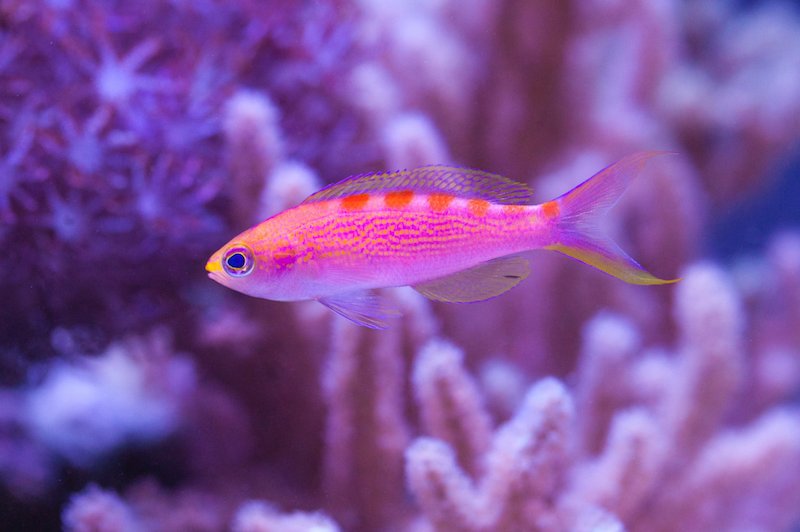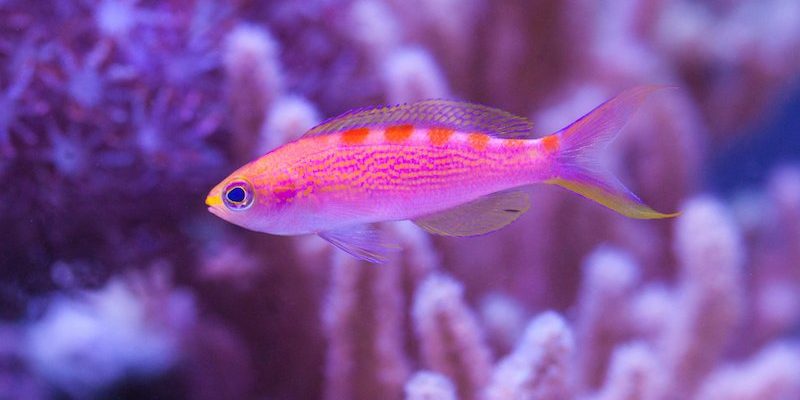
The lifespan of anthias fish can vary based on a few factors, including the specific species, their environment, and how well they are cared for. In the wild, these fish can live for around 5 to 10 years, but in a carefully maintained aquarium, they can sometimes live even longer. You could think of it like a dog; with the right pet care and lifestyle, your furry friend may live longer than expected. With that in mind, let’s explore the factors that influence anthias lifespans and how to create the best conditions for them in your aquarium.
Types of Anthias Species
When we talk about anthias, we’re referring to a whole group of colorful reef fish. The most commonly kept species in aquariums include the lyretail anthias, sunshine anthias, and squareback anthias. Each of these species has its own personality traits and needs, which can play a role in their lifespan.
For example, lyretail anthias are known for their long, flowing fins and bright pink to orange colors, while sunshine anthias flaunt a vibrant yellow hue. The squareback anthias, with their more subdued colors, still pack a personality punch. You might notice that different species have varying requirements for social interactions, tank size, and water conditions.
If you’re new to fishkeeping and considering anthias, it’s good to research each species individually. Some might thrive better in schools, while others are more solitary. By understanding the specific needs of the anthias you choose, you can create a habitat that promotes longevity.
The Importance of Tank Size
Tank size is a crucial factor when it comes to keeping anthias healthy. A larger aquarium allows for better water quality, which is vital for any fish’s health. Generally, a minimum of 50 gallons is recommended for a small school of anthias. If you’re opting for more than a couple, even more space is ideal.
In a cramped tank, anthias may become stressed, leading to health issues that can shorten their lifespan. Stressed fish often display erratic swimming patterns and may hide more than usual. Think of it this way: would you feel comfortable living in a small room with no space to move around? Your anthias feel the same way.
Along with size, the shape of the tank matters too. Longer tanks allow for swimming space, while tall or oddly shaped tanks can restrict movement. If you aim for a thriving school of anthias, choose an aquarium that offers plenty of horizontal swimming space.
Water Quality and Conditions
Maintaining excellent water quality is non-negotiable for the health and lifespan of your anthias. These fish hail from the vibrant reefs of the ocean, where water conditions are stable and clean. In an aquarium, you need to mimic this environment as closely as possible.
Start with proper filtration and regular water changes. You should test the water for common parameters like pH, ammonia, nitrite, and nitrate levels. Ideally, the pH should be around 8.1 to 8.4, and ammonia and nitrite levels should be zero. High nitrate levels can signal a problem and may lead to health issues for your fish.
Additionally, keep an eye on the temperature. Anthias generally thrive in warmer water, around 75-80°F. You might consider a good quality heater to maintain consistent temperatures. If the water quality dips, it can lead to stress and diseases, which can ultimately shorten their lifespan.
Diet and Nutrition
Here’s the thing: you are what you eat, and that goes for fish too! A well-balanced diet helps anthias stay healthy and may extend their lifespan. In the wild, anthias are carnivorous, feeding on zooplankton and small crustaceans. In your aquarium, they can thrive on a mix of high-quality foods.
Try offering a variety of options:
- Flake foods fortified with protein
- Frozen or live brine shrimp
- Mysis shrimp
- Pellets designed for carnivorous fish
You might be wondering how often to feed them. A good rule of thumb is to feed small amounts two to three times a day. Make sure they’re consuming all the food within a few minutes; this helps minimize waste and keeps water quality high.
Remember, overfeeding can lead to obesity and water quality issues, both detrimental to your fish’s health. A balanced diet contributes to a longer, healthier life for your anthias.
Social Interactions in the Aquarium
Anthias are social creatures and often do best in groups. Keeping them in small schools of at least three to five can help reduce stress, promote natural behaviors, and lead to a longer lifespan. They enjoy swimming together and will often form a hierarchy, which is completely normal.
However, not all species of anthias get along well. It’s essential to choose compatible species if you plan to mix different types. For example, keeping a school of lyretail anthias with squareback anthias can create unnecessary competition for resources, which could lead to aggression and stress.
If you’re introducing new fish to your tank, make sure to acclimate them properly. This helps reduce stress during the transition and promotes healthy interactions once they’re in the aquarium. Observing their social dynamics can give you valuable insights into their well-being.
Common Health Issues and Their Impact
Even under the best conditions, anthias can face health challenges that might impact their lifespan. Some common issues include ich, fin rot, and gill flukes. Recognizing the signs of stress or illness is key.
For instance, if your anthias are scratching against objects, it could signal a parasitic infection. Another red flag is if they show a lack of appetite or faded colors—these could be signs of illness or stress.
If you notice any of these symptoms, acting quickly can make a significant difference. Quarantining affected fish and treating them early can prevent diseases from spreading to others in your tank. Plus, maintaining good water quality and a proper diet goes a long way in preventing many health issues.
In summary, anthias can live anywhere from 5 to 10 years in aquariums, but with proper care, they might exceed that. The key is to create an environment that mimics their natural habitat—think tank size, water quality, diet, and social interactions. These fish add life and color to any aquarium, and with the right attention, they can thrive.
So, if you’re ready to take the plunge into the world of anthias, remember to do your research first. Like any pet, they deserve the best care possible, and that dedication can lead to many joyful years with your colorful aquatic friends.

